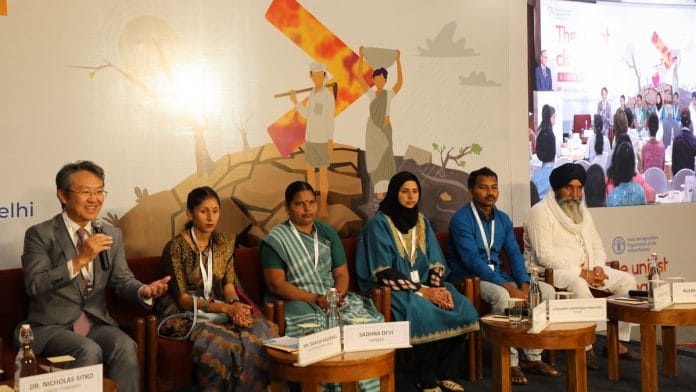New Delhi: Apple farmer Shehnaza travelled from Kashmir to Delhi to address Niti Aayog officials, UN leaders, top scientists, and economists. Temperatures in Kashmir are rising, and our crops are getting spoiled, she said.
Shehnaza was one of many farmers—from Kashmir, Uttarakhand, and other parts of India— who shared their stories at the day-long event, ‘The Unjust Climate – A Focus on India’, organised by the Food and Agriculture Organization (FAO) of the United Nations in October.
The war against climate change is not limited to think tanks, policymakers, and industry. It’s also being waged on the ground by community ‘warriors’ and non-governmental organisations who are empowering marginalised groups in the agrarian sector. The events highlighted their work in addressing food security, climate resilience, and women’s roles in sustainable farming.
The Self Employed Women’s Association (SEWA), for instance, is introducing solar-powered technology to help Kashmiri women apple farmers. In Uttarakhand, the FAO is educating women on how to deal with the vagaries of weather, like unseasonal rains, heat waves and depleting water supply. Panel discussions were held in multiple languages and not just Hindi and English. Participants shared their experiences in Gujarati, Punjabi, and dialects from Uttarakhand and Odisha.
Shehnaza and other women farmers from her village, who once grew only maize and potatoes and struggled to afford basic groceries, have now added vegetables and fruits to their crops, especially apples.
“Women in my village—who once earned nothing—are now growing and selling fruits and vegetables, earning a monthly income of Rs 4,000-5,000 while still setting aside produce for their families,” said Shehnaza.
Also Read: Delhi’s five pollution hotspots
Survival to revival
Extreme heat and unpredictable rains have dealt huge financial blows to apple farmers in Kashmir’s Kupwara region, where Shehnaza lives.
“After picking apples at 6 in the morning, we’d wait by the road for transport that often arrived three or four days late, spoiling our produce,” said Shehnaza. “In the end, we’d be forced to sell them to the Coca-Cola company for just Rs 3.5 per kilogram.”
But SEWA’s intervention turned things around. With solar-powered cold storage and drying facilities, farmers could now store their apples and turn them into crunchy apple chips using solar dryers. Now, Shehnaza earns Rs 700–800 per kilogram of apple chips.
“At SEWA, we’re dedicated to building climate-resilient farming practices so that farmers—often the most vulnerable members of society—can better withstand the shocks of climate change,” said Heenaben Dave, SEWA’s vice president.
A similar story unfolded in Pauri Garhwal district of Uttarakhand, where untimely rains and extreme heat events have created drought-like conditions and left farmlands parched. Farming was no longer being seen as a viable livelihood. The men migrated to cities, leaving women to fend for the fields.
Then, around 2020-21, the FAO, with support from the Global Environment Facility (GEF) initiative stepped in. They reached out to affected villages with information on modern farming techniques and taught women how to cultivate turmeric—a crop they had never grown before—with advanced scientific methods.
“Our turmeric plantation looks promising, even after we had to plant our crops later due to delayed monsoon showers,” said Sadhana, a village head from Uttarakhand, who, like Shehnaza, attended the conference to share her experiences. Where once there was despair, now there is a renewed optimism among farmers in her village.
Sadhana attributed this success to the scientific and sustainable methods learned through FAO’s training. They prepared their fields, added homemade cow dung manure, and applied their new knowledge.
“We improved seed quality by applying Trichoderma (an eco-friendly bio-fungal agent) treatment, drying the seeds in the sun, and sowing them according to the specific size dimensions we learned about during training,” said Sadhana.
Also Read: Climate action is the hot new career. Consultancy, communications, colleges are all in
Sustainability as a two-way street
The discussions made one thing clear— the battle is only half-won if agriculture is protected from climate change, but not vice-versa.
Across sessions, there was an undercurrent of urgency as panellists spoke about soil degradation and water depletion— consequences of large-scale, resource-intensive farming.
“Recognising that agriculture contributes 14 per cent of the country’s emissions, the Government of India launched a National Mission on Sustainable Agriculture in 2010,” said Franklin Khobung, joint secretary, Natural Resources Management, Ministry of Agriculture & Farmers’ Welfare during a panel discussion on inclusive climate action. Natural farming, organic farming, and micro-irrigation are some of the focus areas of this mission.
Khobung made a case for sustainable farming practices, which he said require fewer resources. He added that India started promoting the efficient use of water as early as 2005 and today, more than 10 per cent of the country’s irrigated land uses micro-irrigation, which delivers water directly to the roots of plants, reducing wastage.
In the same panel discussion, scientists spoke about how the impact of climate change goes beyond food quantity to affect nutritional quality as well.
“Rice and wheat crops grown under higher carbon dioxide concentrations have lower protein content,” said PK Ghosh, director of the National Institute of Biotic Stress Management, Ranchi.
“For a just climate transition, we must promote nature-based farming solutions and link them with the community livelihoods,” said Ghosh.
He also reinforced the importance of offering a variety of livelihood options suited to farmers’ economic backgrounds.
“Not everyone can be engaged in the same livelihood,” he said. “Some should take up beekeeping, others can cultivate nutritional gardens, some might raise goats, while others manage poultry.”
But it was the stories of women like Sadhana and Shehnaza that drove the message home.
“We, the women left behind in the village, took it upon ourselves to carry forward the traditional profession of farming, and now we proudly own this practice,” Sadhana said.
(Edited by Asavari Singh)






